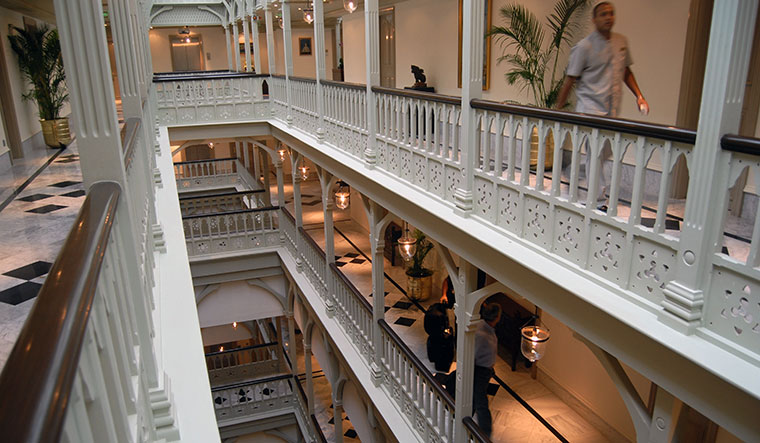IN RUSSI M. LALA’S much acclaimed book, The Creation of Wealth, he begins the chapter named The Taj Mahal with these words: “In the world’s travel circles, if you speak of just ‘The Taj’, they ask you ‘Which one?' Shah Jehan’s dream in marble was born out of his love for his wife. Jamsetji’s handiwork was born out of a love for his city.”
According to Frank Harris, who chronicled Jamsetji Tata's life, he saw that Bombay was failing in providing travellers the comforts and luxuries available in Europe and America. To make matters worse, the city had been hit by a terrible plague. Jamsetji decided to give Bombay a stunning hotel that would not only help restore its image as a great city but also attract foreign tourists. And, because Jamsetji was one of Bombay’s leading businessmen and the most widely traveled men of his time, he planned it on a massive scale.
On November 1, 1898, workmen began sinking the foundations of The Taj. From his visits to exhibitions in Europe and America, Jamsetji ordered lifts and American electric fans for his new hotel. An electric power plant was also installed to power these. A back-up system of gas lights was also at hand. At an exhibition in Paris, he saw spun-steel-pillars, created using a new technology. He immediately ordered a few of them for The Taj’s ballroom and front porch. From a Turkish bath to an electro-polishing machine to a knife-cleaning and sharpening machine, the hotel offered several modern amenities and technologies.
It was also an architectural marvel—an amalgamation of styles, with Rajput bay windows, Edwardian-Gujarati trellises and balustrades and Moorish Florentine domes. The Taj’s massive 240-feet tall central dome still serves as an official daytime triangulation point for ships of the Indian Navy; they fix their positions by taking bearings on Middle Ground and the dome. The Taj opened its doors to guests December 16, 1903. It cost six rupees a night at that time.
The Taj has not been just the pomp and luxury. “Leaders such as Mahatma Gandhi, Jawaharlal Nehru, Sarojini Naidu, Muhammad Ali Jinnah, Khan Abdul Ghaffar Khan and Sardar Patel would gather here and confer about the next steps to be taken for the freedom movement,” says Taljinder Singh, area director, Mumbai Hotels, and general manager, The Taj Mahal Palace. “The Tatas did not charge them a penny.”
Many Indian princes also met at The Taj, before independence, and agreed to give up their rights on their states so that India could become a sovereign nation. “They had multiple meetings and that is why the room where they met is called the Princes Room,” says Singh. Lord Mountbatten’s farewell speech was given at The Taj.
The Taj has been the first address for generations of royalty, delegates, artists and celebrities from around the world. Neil Armstrong, Somerset Maugham, V.S. Naipaul, Sidney Sheldon, Alfred Hitchcock, John Lennon, Zubin Mehta, Mick Jagger, Oprah Winfrey, Barack Obama, Hillary Clinton, Justin Trudeau—The Taj has hosted them all. During Trudeau’s recent visit, he had brought along a sherwani, but forgot matching footwear. The function was an hour away when Singh received a call from the consul general. “They wanted the typical Punjabi jooti, the one which curls in the front,” he says. “Our team picked up five pairs.”
The Taj has a reputation as 'The House of Firsts'—from opening the first licensed bar (Harbour Bar) and the first disco to being the first building in India to be trademarked. “It keeps the flame of innovation alive,” says Singh.
What never ceases to amaze guests is The Taj’s pulsating vibe, which has been bringing a lot of music, dance and fashion into the country. Many artists came via the sea route. Violinist Leon Abbey played at The Taj for several years; cabaret dancers like Catherine Courtney (Madame Pompadour) and troupes like Moulin Rouge also came and performed. “Not only did India’s first fashion show happen at The Taj, but there were also frequent gala balls held within the doors. All this when French chefs tantalised the guests’ taste buds with their finest delicacies,” says Singh.
The Taj's archival room will soon be ready, and it will have everything from the menus of 1911 to photographs, to testimonials, letters written by Sarojini Naidu (she had made The Taj her home for several years) to Nehru and Khan Abdul Ghaffar Khan. “We have the full collection of art catalogued, but we had never catalogued the antiques. So, the origin of the antiques is also being put together,” says Singh.
The Archival Corridor inaugurated on The Taj’s 110th year tells the story of the city, along with the history of the Taj Mahal Tower built in 1973. It also displays pictures of important people such as members of the Tata family from the late 1800s, Queen Elizabeth, who was crowned the Empress of India when she visited for the Delhi Durbar, and freedom fighters. “This is not just a hotel, it is a museum hotel,” says Singh.
In a corner stands the 26/11 Memorial Wall, a grim reminder of the terrorist attack on the hotel in 2008, with names of the guests and staff who lost their lives. “It was exemplary, because the hotel staff put themselves in front of the guests,” says Puneet Chhatwal, managing director & CEO of The Indian Hotels Company. “In fact, there is a Harvard case study on it.”
Unlike the clinical treatment that other hotels often meet out to guests, The Taj does things “from its heart and soul, and that is the difference,” says Chhatwal. “Taj-ness’ is our culture, it is our way of life, it is the way we conduct ourselves, it is the way we do business.”



